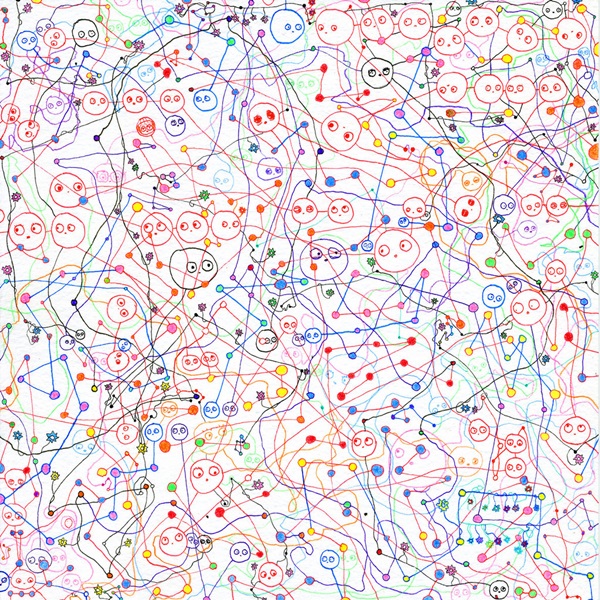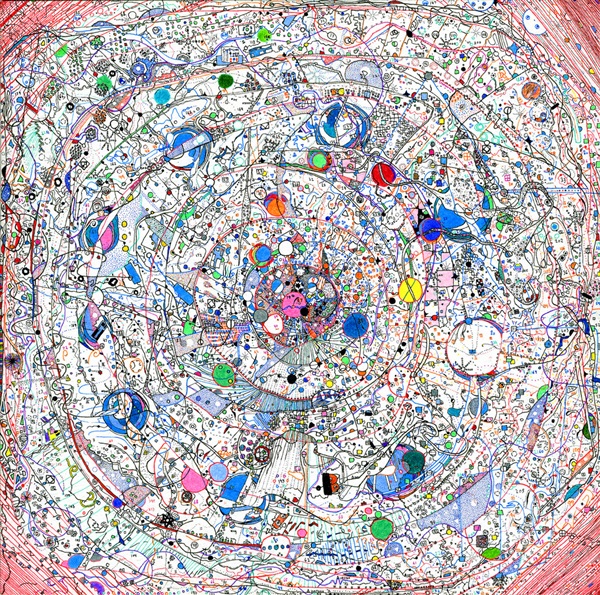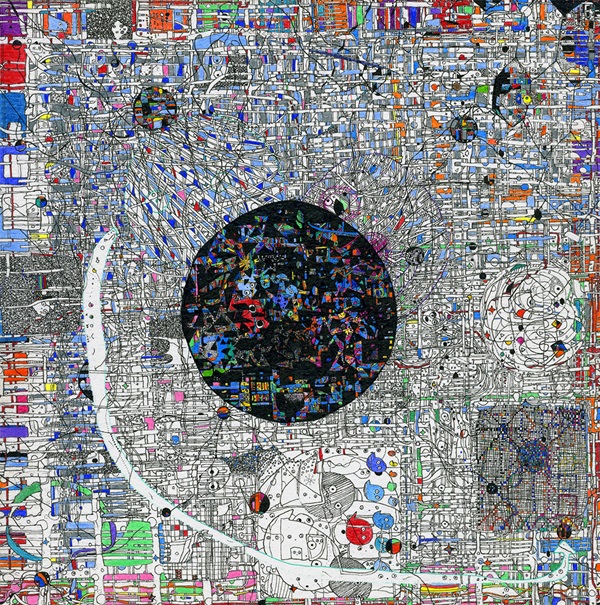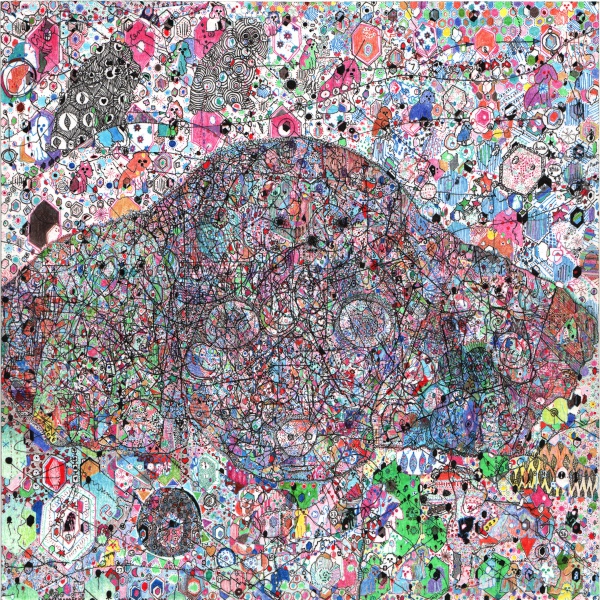People
Artist Tao Lin Encourages You to Flip His Work
He's sold his artworks on eBay with an opening bid of one cent.

He's sold his artworks on eBay with an opening bid of one cent.

Rozalia Jovanovic

Tao Lin is best known for his minimalist, seemingly-autobiographical novels that are obsessed with surface detail (like Shoplifting from American Apparel), for making movies while high (under the aegis of his production company MDMA Films), and for his gimmicks—like selling “shares” of an unfinished novel for $2,000 each. He has even vied with Lena Dunham for the coveted status of “voice of Generation Y.” But the 32-year-old writer and poet is also an artist, and he brings all of the same love of surface detail and flare for gimmickry to the making and selling of his artworks (he’s sold them on eBay with a starting bid of 1 cent), which lately have been mostly drawings of mandalas and his parents’ toy poodle Dudu.
The Brooklyn resident has authored seven books, the last of which, Taipei, was published in 2013 and involves two characters who use a variety of drugs including LSD, Percocet, Adderall, cocaine, and Oxycodone while spending a lot of time on their MacBooks using gchat, Twitter, and Tumblr. When asked once what movie was most like his book, the Taiwan-born writer answered, “Shit… what’s a movie where they use drugs a lot but no one dies and there’s no violence, and it’s funny, but everyone is depressed?” Writing for the New York Times, Dwight Garner called it Lin’s best book, saying, “It has distant echoes of early Hemingway, as filtered through Twitter and Klonopin.”
Lin announced on Twitter in February that Vintage is publishing his next two books: Leave Society, his fourth novel, and Beyond Existentialism, Lin’s first non-fiction book about the life of author, mystic, and ethnobotanist Terence McKenna and Lin’s own interest in psychedelics (the book is loosely based on his Vice column) as well as his fascination with death, aliens, the end of history, and the future of humankind.
I interviewed Lin, over email, about his work.
You have often been spoken of as a poster-boy for disconnected youth who are nonetheless highly connected to technology and the Internet, and many of your novels include young people communicating on gchat. But here you are putting pen to paper for these drawings, which seems at odds with the very hyper-connectedness of the youth you’ve come to represent. How do you see the artwork in relation to your writing? Is it an antidote to all that gchatting?
My second novel had a lot of dialogue occur on gchat, but to me the characters were not hyperconnected to technology and the internet. They were just not deliberately staying away from the internet. Probably ~99% of people reading this are highly connected to technology and the internet, so to me it seems like a normal amount of connection. Drawing is antidotal in that I like being away from my computer and the internet while drawing. In relation to my writing, I see my visual art as just existing there also, in the world, with my writing.

Tao Lin, Mandala 7 (2015).
Image: Courtesy of Tao Lin
Carl Jung has written about mandalas as an archetype and refers to it as “the psychological expression of the totality of the self.” Does your choice of the mandala have anything to do with Jung?
I don’t think so. I haven’t read Jung’s thoughts on mandalas, only people’s thoughts on Jung’s thoughts on mandalas. Terence McKenna said this, which I like: “Jung tried to get his patients to make mandalas, because he said they were totality symbols. Well, eventually, the totality symbol is more than a symbol. It actually becomes a true map of the totality.”
I like that monks meticulously create complicated mandalas from colored sand, then sweep the sand into a container and throw the container, I think, into an ocean. And I like to think of mandalas as representations of worlds. While drawing I will sometimes imagine I’m creating a world that I’ll have to exist in, or that I’d like to explore, or that someone I like will one day get to explore or be forced to exist in or be condemned to eternally study, among other scenarios.

Tao Lin, Mandala 12 (2015).
Image: Courtesy of Tao Lin
I heard you sold your mandala drawings on eBay. How much do they go for?
I sold 11 on eBay. They sold on average for ~$350 maybe. I’ve stopped selling them on eBay and basically now I just make them and look at them and show my parents.
Why did you sell them there? Wouldn’t you want to have more control over where they wind up or how much they sell for?
I like being able to set the starting bid at 1 cent, then not having to think about it anymore. I like having people decide what they want to pay, so I don’t have to set a price and worry about it. The main thing for me with these is what I feel, think, and remember while drawing and while looking at the art (I will often suddenly remember events and dreams from years ago as non sequiturs). I don’t want to care about the physical piece. I mean, I want to scan it afterward, so I can look at it in the future, and remember what I thought and felt and remembered while making it, but after that I don’t want to care what happens to it.

Tao Lin, Mandala 9 (2015).
Image: Courtesy of Tao Lin
Have you ever thought of showing them to an art dealer? Does the idea of having an art dealer even appeal to you?
I feel unmotivated to unsolicitedly send emails or talk to anyone I don’t know to get anyone to look at or buy my art, but I’m open to having someone email me and tell me what they want to do about my art.
If you could have one critic in the art world review these works, who would it be?
I don’t think I know any names of critics in the art world. I’d be interested in reading a review of them by someone who likes fractals, DMT, psilocybin, dreams, Terence McKenna, and Jackson Pollock.

Tao Lin, Mandala 10 (2015).
Image: Courtesy of Tao Lin
Do you know anything about anyone who bought one of your mandala works?
The editor of Fanzine, the editor (I think) of Thought Catalog, an employee at MakeSpace, a freelancer for the New Yorker and other places (some of these are friends), and four to six people I don’t know.
Has anyone ever tried to resell them?
Not that I know of. Some have framed them and sent me pictures.
If you saw that someone put one up for auction at Phillips and it sold for, let’s say, $100,000 (after you only got $350 on eBay), would it upset you?
Not at all! I encourage that to happen.

Tao Lin, Untitled (2016).
Asked what inspired him about Dudu, his most recent muse, Lin responded: “She is my parents’ toy poodle. She lives in Taipei with my parents. I’m inspired by how attentive she is. When I’m in my apartment with my parents and Dudu, Dudu is always looking at us, making eye contact with each of us, being aware of where each of us is and what we’re doing. I’m inspired by Dudu’s stretching. She stretches very often and intensely, doing yoga-like poses frequently. I’m inspired by Dudu’s love for and excitement, after time apart, to reunite with—in this order—my dad, my mom, and probably my aunt. I’m inspired by Dudu in other ways.
Image: Courtesy of Tao Lin
This interview has been edited and condensed.